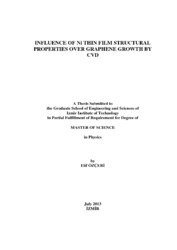Please use this identifier to cite or link to this item:
https://hdl.handle.net/11147/3566Full metadata record
| DC Field | Value | Language |
|---|---|---|
| dc.contributor.advisor | Selamet, Yusuf | - |
| dc.contributor.author | Özçeri, Elif | - |
| dc.date.accessioned | 2014-07-22T13:51:49Z | - |
| dc.date.available | 2014-07-22T13:51:49Z | - |
| dc.date.issued | 2013 | - |
| dc.identifier.uri | http://hdl.handle.net/11147/3566 | - |
| dc.description | Thesis (Master)--Izmir Institute of Technology, Physics, Izmir, 2013 | en_US |
| dc.description | Includes bibliographical references (leaves: 132-145) | en_US |
| dc.description | Text in English; Abstract: Turkish and English | en_US |
| dc.description | xix, 145 leaves | en_US |
| dc.description.abstract | This thesis work focused on the effect of polycrystalline Nickel (Ni) TM thin film structure on the growth graphene by chemical vapor deposition (CVD). TM films were deposited by magnetron sputtering technique on Si/SiO2 substrates. To grow 1-2 layer graphene on Ni thin film catalyst by methane decomposition thermal CVD method was carried out using various growth parameters. To reduce the TM film surface roughness and grow larger size graphene layers on Ni film, Si/SiO2 substrates were coated by a thin Al2O3 buffer layers and Cr adhesive layers by magnetron sputtering. Ni film crystal structure and surface roughness, which affected the number of graphene layers, were examined by X-ray Diffraction (XRD) and Atomic Force Microscopy (AFM) techniques, respectively. The thickness and columnar structure of the films were measured from Surface Profiler and Scanning Electron Microscopy (SEM) images. Ni films were annealed at 800 oC, 900 oC and 950 oC in order to improve their crystal quality and to evaluate the effect of the crystallinity on graphene growth at atmospheric pressure. Samples were studied using XRD and AFM also to assess their crystal quality after the annealing process. It was observed that the calculated grain sizes depended on the film thickness and the annealing temperature. Surface roughness of the films was increased by increasing film thickness. A sole thin Al2O3 buffer layer reduced the surface roughness significantly. However, sole Cr adhesive layer or Cr/Al2O3 buffer layers did not reduce the surface roughness, but increased the crystallinity of Ni films in (111) direction. Argon, Hydrogen or a mixture of these two gases was added to methane during graphene growth at ambient pressure by CVD. The Raman spectroscopy was utilized in order to determine the number of the layers and quality of graphene growth over the Ni catalyst film. | en_US |
| dc.language.iso | en | en_US |
| dc.publisher | Izmir Institute of Technology | en_US |
| dc.rights | info:eu-repo/semantics/openAccess | en_US |
| dc.subject.lcsh | Graphene | en |
| dc.subject.lcsh | Thin films | en |
| dc.subject.lcsh | Catalysts | en |
| dc.subject.lcsh | Raman spectroscopy | en |
| dc.subject.lcsh | Chemical vapor deposition | en |
| dc.title | Influence of Ni Thin Flim Structural Properties Over Graphene Growth by Cvd | en_US |
| dc.type | Master Thesis | en_US |
| dc.institutionauthor | Özçeri, Elif | - |
| dc.department | Thesis (Master)--İzmir Institute of Technology, Physics | en_US |
| dc.relation.publicationcategory | Tez | en_US |
| dc.identifier.wosquality | N/A | - |
| dc.identifier.scopusquality | N/A | - |
| item.cerifentitytype | Publications | - |
| item.openairecristype | http://purl.org/coar/resource_type/c_18cf | - |
| item.languageiso639-1 | en | - |
| item.openairetype | Master Thesis | - |
| item.fulltext | With Fulltext | - |
| item.grantfulltext | open | - |
| Appears in Collections: | Master Degree / Yüksek Lisans Tezleri | |
Files in This Item:
| File | Description | Size | Format | |
|---|---|---|---|---|
| T001098.pdf | MasterThesis | 8.69 MB | Adobe PDF |  View/Open |
CORE Recommender
Page view(s)
282
checked on May 12, 2025
Download(s)
82
checked on May 12, 2025
Google ScholarTM
Check
Items in GCRIS Repository are protected by copyright, with all rights reserved, unless otherwise indicated.